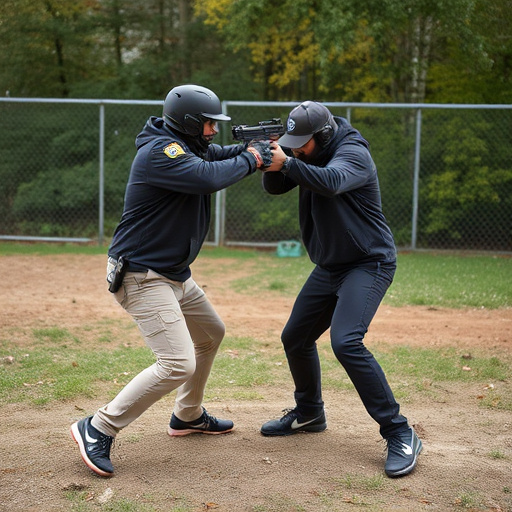Pepper spray poses significant risks to pets due to capsaicin's adverse effects. Immediate action is crucial upon exposure: rinse with water for 15 minutes and seek vet care. Recognize symptoms like excessive pawing, panting, breathing difficulties, and provide comfort. Choose animal-specific pepper sprays with lower capsaicin levels to avoid harm. Proper training, understanding spray mechanics, and treating pet exposure are essential for safe use.
In today’s world, pet owners are increasingly equipping themselves with handheld pepper spray defense units as a means of self-protection. However, understanding the impact of pepper spray on pets is crucial before adopting this strategy. This article delves into the effects of pepper spray on animals, offers immediate care strategies for treating exposed pets, and explores why handheld defense units can be valuable tools for pet owners. Learn how to choose the right spray and follow essential precautions for effective use.
- Understanding Pepper Spray Effects on Pets
- Symptoms and Immediate Care Strategies
- Handheld Defense Units: A Pet Owner's Tool
- Choosing the Right Spray for Pet Safety
- Training and Precautions for Effective Use
Understanding Pepper Spray Effects on Pets
Pepper spray, while an effective personal defense tool for humans, can have significant and often severe effects on pets if they are exposed. Understanding these effects is crucial when considering its use in public spaces or during situations that might involve animals. The active ingredient in pepper spray, capsaicin, irritates the eyes, nose, and respiratory system, causing temporary blindness, difficulty breathing, and intense pain. In dogs and cats, this can lead to panting, drooling, vomiting, and even seizures, especially if they inhale large amounts of the spray.
Treating pets exposed to pepper spray requires immediate action. Rinse the affected area thoroughly with water for at least 15 minutes to dilute the capsaicin. Seek veterinary care as soon as possible, as symptoms may persist or worsen without treatment. Calming and comforting your pet during this time is essential to help reduce their stress levels. Remember that each animal’s reaction can vary, so observing their behavior closely will aid in determining the best course of action for their specific needs.
Symptoms and Immediate Care Strategies
If your pet is exposed to pepper spray, it’s crucial to act quickly. The symptoms can vary but often include excessive pawing, tearing, panting, and difficulty breathing. In severe cases, pets may experience muscle tremors, nausea, or even collapse. Immediate care strategies should focus on neutralizing the effects of the spray and providing comfort to your pet. Start by moving your pet to a safe, well-ventilated area to minimize exposure. Rinse their eyes gently with lukewarm water for at least 15 minutes to flush out any remaining spray. For pets with respiratory distress, provide fresh air and seek veterinary assistance promptly. Treating pets exposed to pepper spray requires swift action and gentle care to ensure their comfort and well-being during recovery.
Handheld Defense Units: A Pet Owner's Tool
Handheld defense units, designed for personal safety, have become valuable tools for pet owners as well. In situations where pets are exposed to potential threats like aggressive animals or even human aggressors, these compact devices offer a quick and effective solution. Pepper spray, when deployed responsibly, can deter an attacker, giving the pet and its owner precious time to retreat and seek help.
Treating Pets Exposed to Pepper Spray involves immediate care. It’s crucial to keep the affected area clean and moisturized to alleviate discomfort. Professional veterinary assistance should be sought for persistent or severe symptoms. Proper training in the use of handheld defense units ensures that pet owners can respond calmly under stress, enhancing their ability to protect both themselves and their beloved pets effectively.
Choosing the Right Spray for Pet Safety
When selecting a handheld pepper spray unit for personal defense, it’s crucial to consider pet safety, especially if you have furry companions at home. Not all pepper sprays are created equal when it comes to treating pets exposed to them. Regular law enforcement-grade pepper sprays can cause severe irritation or even more serious health issues in animals due to their high capsaicin concentration.
For pet safety, opt for animal-specific or vet-recommended pepper spray formulas designed with lower concentrations of capsaicin to minimize harm. These specialized products are formulated to deter aggressors without causing lasting distress to pets. Always read the label and follow manufacturer instructions to ensure a safe environment for both you and your loved ones, including your furry friends.
Training and Precautions for Effective Use
Proper training is essential for ensuring effective and safe use of a handheld pepper spray defense unit. Users should attend comprehensive courses that cover not only the technical aspects of operation but also tactical deployment strategies. Understanding the spray’s range, potency, and deactivation processes is crucial. Additionally, training must include scenario-based exercises to simulate real-world situations, enhancing quick decision-making skills under pressure.
Precautions are equally vital, especially when considering Treating Pets Exposed to Pepper Spray. In case of accidental exposure, keep pets in a safe, enclosed area and seek veterinary assistance promptly. Unlike humans, animals may not be able to communicate their discomfort or distress effectively, so observant owners must remain vigilant. Regular maintenance of the spray device and proper storage are also key precautions to prevent accidental discharge and ensure its reliability when needed.
Pepper spray can be a powerful tool for pet owners, but it’s crucial to understand its effects on animals and employ proper precautions. By recognizing symptoms of exposure and knowing how to administer immediate care, as well as choosing the right handheld defense unit and training accordingly, pet owners can ensure their safety without causing undue harm. Remember, responsible use of pepper spray can make a significant difference in protecting your pets from potential threats.
